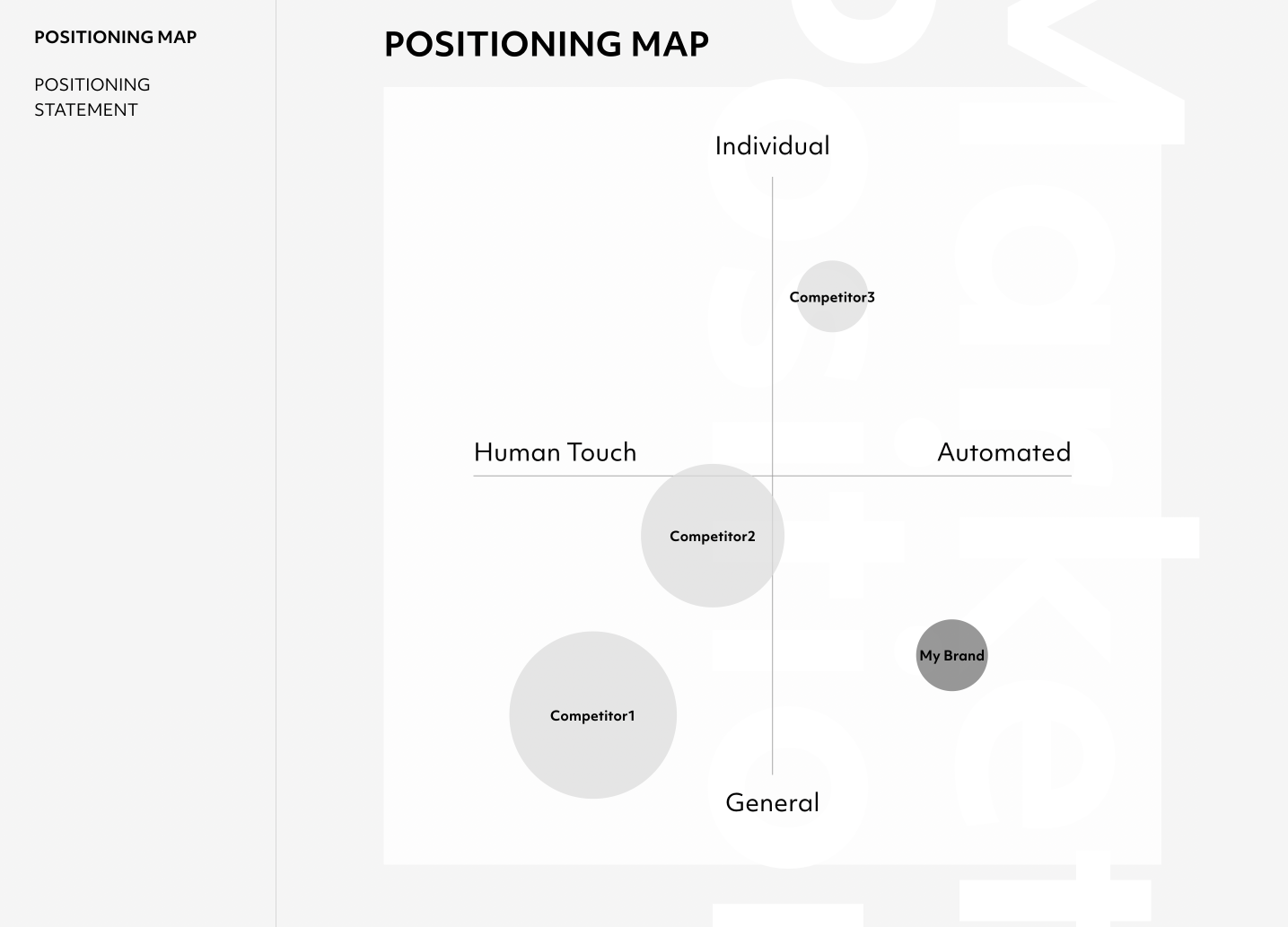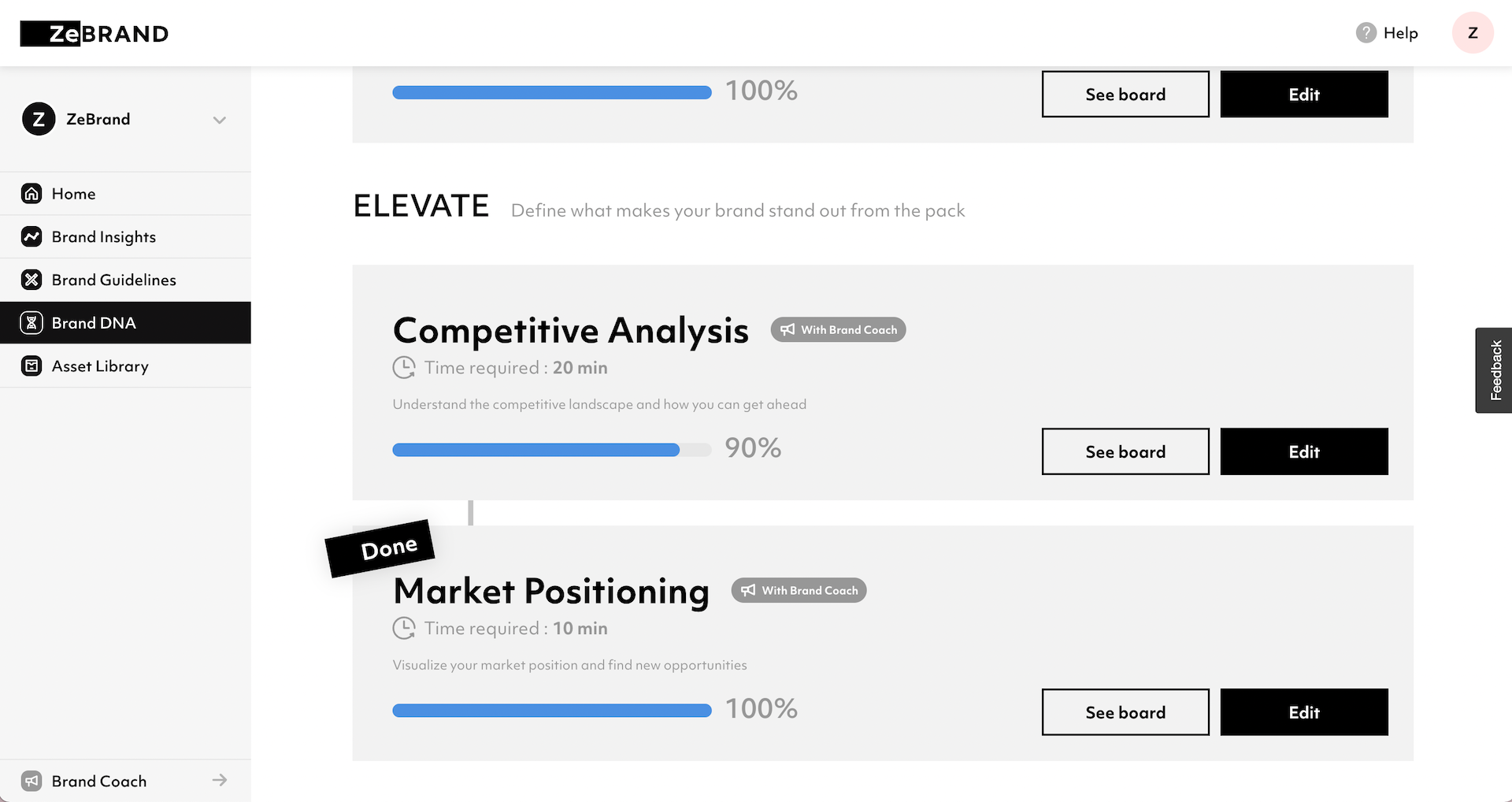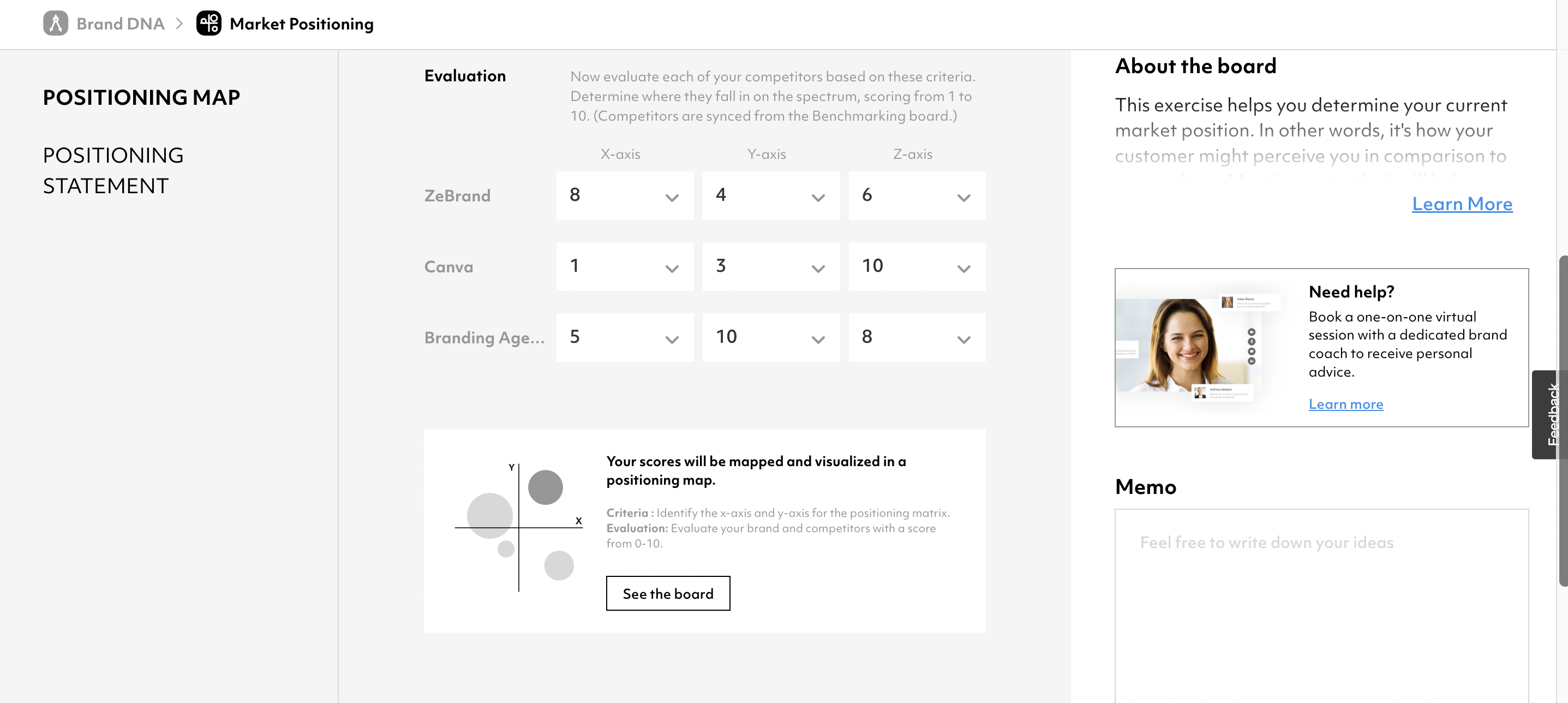How to Establish Strong Brand Positioning for Target Customer

Visualize your market position and find new opportunities
At ZeBrand, we believe your vision deserves to be seen and realized. In this content series, we help you use the brand as a tool to power up your business and jumpstart your growth.
Welcome to Part 5 of A to Ze of Brand Building -- 'How to Establish Strong Brand Positioning for Target Customer.' (Read Part 4 hereif you missed it!)
What makes a brand successful? Is it the company's outstanding products? Its above-and-beyond customer service? Or its innovative design?
A company's success doesn't just come from what it produces. It's also determined by the brand positioning strategy.
When you consider the biggest brands in the world, the brands you would recognize in an instant, you're recalling those companies' brand positioning. And the stronger, more consistent, and more unique those companies' brand positioning, the more likely you are to remember them!
Photo by Melanie Pongratz on Unsplash
At first attempt, shaping a company's brand can be an overwhelming task.
The possibilities are endless, and it can seem easy to make decisions based on purely subjective preferences: Some people like red, some like blue. Some in your team may believe it’s best to “play it safe”—to settle on a brand look that’s in line with industry expectations. Others may believe it’s better to disrupt the status quo—to make a statement with something more daring.
This is a dilemma that even the biggest brands face in due course. As our habits and lifestyles change along with ever-evolving technology and shifting cultural norms, brands must redirect themselves to keep up with consumer interest. Suddenly, companies are breaking away from tradition and defying expectations: Insurance companies like Lemonade are going mobile-first and boasting playful illustrations with bright pink overtones. High-fashion brands like Louis Vuitton and Gucci are channeling more and more of a casual streetwear look. Casper has proven that even mattress shopping can be fun and exciting.
So how do you figure out your unique brand position in the current market landscape? How do you cut through subjectivity and make the right choices for your company?
Thankfully, there’s a science behind it all.
‘Brand Positioning’ refers to how someone perceives your brand in relation to your competitors, industry, and—most importantly—their daily lives. Your brand positioning clarifies what it has to offer and why consumers should choose your brand over an alternative. You could develop positioning for your brand as a whole, or for individual products. Sometimes it can appeal to new customers by making them aware of a problem they never knew they had.
What is brand positioning?
Brand positioning is what makes your brand unique in the marketplace. It's not tied to any one feature or attribute; it's the combination of your company's voice, values, visual identity, and personality. In an instant, your brand positioning tells the world who your company is, who you want to reach, and how you're going to do it. That's why it should be one of the most tailored, targeted elements of your brand strategy.
Brand positioning your brand well is crucial to the long-term success of your business
It's hard to understate how important brand positioning is to the success of a company. In fact, in a 2018 study by the global planning firm Gensler, an astonishing 94% of customers will recommend a brand they've developed an emotional connection with. Another study revealed that brands that show up consistently and uniformly in a variety of places increase their revenue by 10-20% or more!
Why is brand positioning essential to your customer connection? If your customers don't know what makes your product or service different from your competitors, what motivation do they have to shop with you? But when you clearly define your brand position and why you're the best choice for customers who care about (insert your brand positioning statement!), they're more likely to choose you and remain loyal.
Establishing your brand's positioning is one of the first things you should do when launching a business
If you're in the beginning stages of creating your business, now is the time to start thinking about your brand positioning. Once established, everything you create should support that market position. For example, if you're aiming to be the most eco-friendly, sustainable brand in your industry, every element of your brand strategy, including your voice, messaging, visuals, and values, should match that positioning.
If your business is already established, it's not too late to position yourself. It may take more time and effort to position an existing business, but through strategic rebranding, you can carve out an area in your target market.
What are the 5 main types of brand positioning?
How you position your brand will vary a bit by industry. But overall, most positioning strategies fall into one of these five categories:
- Customer service brand positioning. With this strategy, you're aiming to offer the best positive experience for your customers. Enhancing the customer experience is its number one priority.
- Convenience brand positioning. This strategy refers to brands that offer extraordinary convenience. Such as a better mobile app, more locations, or an easier buying experience.
- Price brand positioning. Low-cost alternatives typically fall into this positioning category. You satisfy customers that want to save money with low prices.
- Quality brand positioning. This strategy focuses on the quality of products or services, more than the price or convenience. This means you may sell at a higher price point but provide the utmost high-quality offerings.
- Differentiation brand positioning. Brands that develop an especially unique, innovative, or uncategorizable product fall into this category. You create your own distinctive place in the marketplace.
The best brand positioning strategy for your brand isn't always straightforward. Your brand positioning may utilize a mix of these various strategies to create a highly targeted brand strategy that truly helps your product or service stand out.
But before you start strategizing your own brand positioning strategy, note this: Brand positioning is about more than just being different. Any company can be different. But successful companies are different in a way that appeals to their target customer and builds customer satisfaction.
How to compare brands' positions in the marketplace: Brand Positioning Maps and Brand Positioning Models
Once you've established your own brand's positioning, it's time to see how you compare to your competitor's offer— and make adjustments as necessary. But comparing attributes and positions may feel impossible. After all, price, quality, and convenience are measured differently!
Building a brand positioning map is easy to see how your brand stacks up. This visual graph compares two attributes simultaneously, price and quality, to know where each competitor stands.

By creating a map for each set of attributes you’d like to compare, you can begin to see how your company fits into the market. You're in a strong position if you tend to beat out your competitors. If your competitors tend to outrank you on several positioning maps, revisit your brand strategy!
Last but not least, sum it all up with a brand positioning statement
Brand positioning statements are usually short sentences that describe what you do, who you do it for, and why you're different.
Like your vision and mission statements, your brand positioning statement should be unique, clear, and memorable. It's the guide you'll use to build your brand from today, forward!
How do you decide on an effective brand positioning?
Figuring out the best positioning for your brand can feel like guesswork at first, but at its core are three simple steps to keep you on track:
Step 1: Distill Your Brand’s Unique Value
Whether something is valuable or not is ultimately up to consumers' perceptions. But in order to help them realize your brand’s value proposition, you must identify and amplify what is uniquely distinct about your brand and offering. The ideal brand positioning is composed of three ingredients:
Ingredient One: A Company's Origins
When it comes to brand DNA, no two companies are identical. Because of their histories, capabilities, and past experiences, all companies have unique origin stories to draw from. For instance, Tesla is known as a pioneer for visionary thinking, has a history of defying expectations, and was birthed by an intensely focused founder who possesses boundless imagination and drive. No matter what Tesla does or creates, its brand image will always have this halo over it.
Ingredient Two: Distinctive Product Attributes
The company's offering also has its own unique features and quality products. When Tesla released Cybertruck, it boasted its powerful towing capacity and Blade Runner-esque design — both of which align with the brand’s reputation for mixing function and fantasy.
Ingredient Three: Customer Characteristics
To brand position effectively, it’s important that your brand promise and product attributes align with your target customer expectations, or that you identify a target audience you can readily serve with existing strengths. Cybertruck, for instance, is less about practical performance than it is about hi-tech design. This suggests that rather than targeting contractors and truckers, their target audience is more niche, in the urban professionals' realm or tech fanatics.
Mixing it all together
So how might you put this information together for your brand positioning? Here is an example based on a real product brief for Google Chromebook:
Schools all over the world are making commitments to improving students’ digital literacy. They need durable products to purchase in mass that require low maintenance. Google has decided to address this need and create a brand for a computer that can serve this market conditions.
Google is known for broadening the world’s access to information as well as powering Google Chrome, an easy-to-use internet browser with a broad range of plug-ins (company origins). More recently, it has also found a way to build Chrome into a full operating system that allows computers to boot up in a matter of seconds and package it into low cost hardware (distinctive product attributes). You always need to be connected to the internet to use it. But that's no problem for schools and for that matter, many everyday people who are almost always online (customer characteristics).
All of this information can be distilled into a defensible brand positioning statement that only the Google Chromebook can own:
An instant portal to a world of knowledge available to all students.
When you create your brand positioning statement, keep it succinct and practical: who is this for, what solution do you offer, and why it is distinctive in your customers' lives. Your brand positioning statement will be the one-sentence response to all three of these questions.
Photo by Charles Deluvio on Unsplash
Step 2: Understand the Codes That Your Industry Uses to Communicate
Within any industry are cues and symbols that reflect what customers have traditionally valued and looked for when choosing products and services of that category. It's essential that you conduct market research to identify these customer expectations through an industry audit. This audit will help inform how your brand addresses your target market needs.
If you’re creating a new banking app, for example, have a look at the visual and verbal language of the finance industry in general. Look at the logos, colors, and imagery of retail banks, investment firms, insurance companies, and payment apps. Once you identify the commonalities, what you’ll have are the ‘codes’ of the industry. For finance, this could be pleasant imagery of families on vacation evoking a worry-free life, or commonly used words like ‘control’ and ‘confidence’ that assure customers of being in good financial hands.
Step 3: Choose to Either Harness the Codes, Break Them, Or Borrow From Another Category
Once you have a clear understanding of your industry codes, you can now strategically decide which ones reinforce your brand positioning and which don’t. You may realize that you’re serving a market that is set in its ways, and therefore, it’s more important to harness the industry codes—to be recognized as a formidable competitor rather than a new challenger. In adhering to the codes of your industry, you may choose to use similar imagery, colors, and language to evoke familiarity and trust. Or, conversely, if your target market is youths who are tired and skeptical of traditional financial organizations, you may need to break the industry codes to truly make a splash.
There’s also one more option, which is borrowing cues from another category. Because of the pace of innovation, consumers’ expectations are standardizing across categories. Users may want the same degree of instant gratification that they get from Netflix from their banking app. Or the same level of convenience they get from Uber Eats from a pharmaceutical company. Think about how you can take codes and associations from other industries to give your brand a new point of difference.
We live in a market landscape today that is branding’s most interesting era thus far. Rules are being changed and broken every day. So in this complex world of signs and symbols, how do you find your way? Remember to distill your unique value proposition, understand the codes of your industry, and decide which ones to harness or break. Then make it all visible in your brand identity design, which is precisely where we turn our attention to in our next article -- how to visualize your vision.
Three examples of effective brand positioning
Need examples of brand positioning to help guide your own branding work? Check out these three examples of companies who nailed their positioning— and secured a strong share of their market.
- Coca-Cola. This company has positioned itself as a happy, light-hearted, positive brand. The name and visual identity convey a refreshing experience.
- Slack. This B2B brand is all about convenience. Slack's positioning statement is to “Make work-life simpler, more pleasant, and more productive.”
- Dollar Shave Club. As the name suggests, Dollar Shave Club is positioned as an affordable alternative to expensive shaving products. This brand is all about affordability, convenience, and ease of use.
Can you see how positioning yourself in the market makes your brand more memorable? Rather than trying to appeal to every person, strategic positioning causes your smaller group of ideal customers (and future raving brand fans!) to recall your brand first. And that familiarity becomes valuable customer loyalty.
ZeBrand's best tool for brand positioning
When you build your Brand DNA with ZeBrand, you gain access to our suite of premium branding tools. In the Elevate stage of our guided branding process, you'll find our Market Positioning tool. This is where you'll find your brand positioning framework.

In the Elevate stage of building your brand DNA, you'll define your brand positioning strategies on a deeper level.
This user-friendly tool will walk you through an exercise designed to define your current market position— and where you want to go in the future.

You'll be guided through every step of the branding process. Even new entrepreneurs with limited branding experience can launch a successful brand with ZeBrand.
Not only does the Market Positioning tool help you understand your current brand positioning, but you can also compare your position to other brands. In just a glance, you can see how your product or service ranks, where the biggest opportunities are, and where you have room to differentiate further.


This detailed evaluation reveals areas your brand can improve to gain greater market share, so your brand stands out from the competition.
After conducting market research and positioning yourself to gain a competitive advantage, you can then go on to create a marketing strategy that will ensure a positive emotional response! You can consider yourself successfully positioned when your brand purpose is easily distinguishable from what your competitors offer.
Ready to create your own successful brand positioning strategy? ZeBrand can help!
Whether you're starting a new business or rebranding an existing one, ZeBrand's expert team of Brand Coaches and a full suite of brand-building tools will simplify the process. To launch your own branding project, start here.
A to Ze of Brand Building is a 10-part series about all things branding, with an eye to using branding to engage your customers and grow your business. Continue on to Part 6: The Beginnings of Visual Identity.


